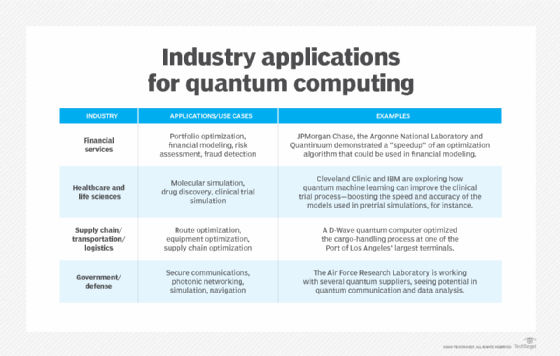
Getty Images
Meet quantum needs with hybrid digital infrastructure
The potential for quantum computing remains unparalleled. Does your organization understand the demands quantum computing will have on digital infrastructure?
Quantum infrastructure stands to revolutionize digital processing and complex problem-solving across diverse fields, including biotech, finance, pharmaceuticals, materials design and cryptography.
Since the 1980s, scientists have applied quantum capabilities to process massive amounts of data, deliver results and simulate complex molecular and physical systems instantly. Current quantum use cases include navigational devices, MRI technology and supply chain optimization. Despite quantum computing's dependence on highly stable and environmentally sensitive environments, today's data centers can host quantum systems on premises. This means organizations can expect adoption to happen sooner rather than later, especially as hybrid approaches fast-track adoption.
Organizations must embrace a transformational approach to digital infrastructure as they face challenges with quantum scalability, energy sources, infrastructure modifications and hardware. C-suite and technology leaders must prepare for quantum infrastructure to disrupt everything.
How organizations can benefit from quantum
Quantum computing is based on the principles of superposition and entanglement, where qubits -- the fundamental units of quantum data -- can exist in a superposition of both 0 and 1 states simultaneously. This enables quantum computers to explore multiple solution paths in parallel, providing an extraordinary computational advantage for specific use cases.

Quantum computers require extreme operating conditions, such as temperatures near absolute zero and complete isolation from environmental interference. While this infrastructure is highly specialized and expensive, businesses can access quantum computing through cloud platforms or strategic partnerships, enabling them to explore opportunities for innovation and competitive advantage without massive infrastructure investments.
The potential for quantum computing to create business value in its current form is based on four types of computational problem-solving: optimization, simulation, machine learning (ML) and cryptography. Consider the following use cases:
- Optimization. Theoretically, through optimization problem-solving, quantum processing could swiftly evaluate numerous possibilities and deliver options for achieving a desired outcome. This is critical in fields such as logistics, resource management and financial modeling.
- Simulation. This could enable companies to model complex phenomena and expedite breakthroughs in diverse fields, including chemistry-based drug discovery and materials design.
- ML. Quantum can improve ML capabilities and enable ML tools to analyze thousands of variables across millions of transactions, significantly outpacing algorithms.
- Cryptography. Conventional encryption methods, assisted by quantum key distribution (QKD), create secret strings of characters -- cryptographic keys -- and securely exchange them to safeguard data traffic.
What does quantum infrastructure require?
Leaders can gain crucial insights by comparing the differences in infrastructure between quantum computing and traditional data centers. Consider the following facets of traditional versus quantum computing:
- Cooling. Within a quantum environment, superconducting circuits ensure zero electrical resistance when cooled. These circuits require environmental controls to function properly, such as vibration-free vacuum chambers, dilution refrigerators and electromagnetic shielding. Compare this to the ubiquitous HVAC cooling and ventilation systems that protect traditional servers from overheating.
- Storage. The storage components for standard digital processing include data pools, files and block storage. However, quantum entanglement uses the phenomena of influence and interconnectivity, where information in one qubit affects data within another. Quantum memory systems store quantum states -- including entangled states -- enabling quantum information to be preserved and retrieved on demand. Quantum networks use photons transmitted through optical fiber and free space to share quantum information between distant quantum processors.
- Middleware. Middleware helps allocate classical and quantum resources by optimizing infrastructure through quantum hardware virtualization and generating software-defined interfaces. APIs enable interconnectivity between on-premises classical and quantum systems. They define the rules for how the two distinct systems interact, and democratize access to core computational elements, such as qubits, quantum gates and circuits.
Other important aspects of hybrid infrastructure for quantum processes include switchgear and energy sources. In quantum computing, processing power increases in tandem with qubits, while total power consumption scales at a lower rate. In fact, quantum uses less energy than other breakthrough technologies, such as AI and ML.
However, the sensitive and fragile nature of quantum processing requires a consistent on-premises power source. Equipment is susceptible to damage, and power fluctuations and surges can create operational errors. Uninterruptible Power Supply (UPS) systems supply clean, consistent power and prevent harmful malfunctions. A UPS source functions as a buffer against blackouts, voltage fluctuations and surges. This is crucial since quantum data center infrastructure can consume a considerable amount of electricity.
With all this innovation in computing technology and infrastructure, it's understandable that organizations might want to avoid hefty Capex costs. This is where a hybrid or pay-as-you-go approach could benefit businesses.
A digital-first quantum strategy: hybrid or QaaS?
Companies that develop or purchase hybrid systems accelerate their exposure to quantum technology. This can boost organizational ROI, as even small-scale experimentation can avoid the consequences of waiting and losing competitive advantage. Quantum-classical hybrid data centers can function similarly to the transition between CPUs and GPUs in AI use cases. Some workloads might handle large amounts of data and require a GPU, while other low-latency tasks can use CPUs.
Early adopters across every industry face infrastructure design challenges with quantum. Organizations should prepare to adopt specialized components, such as dilution refrigerators, cryogenic capabilities and insulators to prevent noise and electromagnetic disturbances. Retrofitted hybrid infrastructures also require precise environmental controls, dedicated quantum experts and specialized operations teams to meet these challenges.
A Market.us research report from September 2024 showed an increase in enterprise adoption of quantum-as-a-service (QaaS) among the finance, telecommunications, pharmaceutical and defense industries. Organizations choose this approach to run sensitive or latency-critical tasks on-premises while using cloud providers for on-demand quantum access and QA. This can help alleviate some organizational responsibility for building infrastructure that meets quantum demands. Moreover, shared or public cloud services democratize access, provide quantum operational expertise and supply multiple types of hardware.
Assessing quantum adoption readiness
C-suite and IT decision-makers must maintain a flexible outlook and assess viability as this technology matures. Create an assessment framework that illustrates where quantum advances align with business goals and identify operational capabilities that coincide with enterprise quantum strategies.
A hybrid quantum infrastructure checklist
Use this free checklist to strategize for your investment in quantum infrastructure and prepare the necessary resources and goals.
An effective project plan addresses the current landscape of quantum technologies, identifies key infrastructure challenges, confirms current resources and uses those operational insights. Ask: How can we address specific industry challenges with quantum computing?
Successful adoption initiatives also require enterprises to stay informed of quantum development timelines and breakthroughs in infrastructure design. Organizations can join with academic institutions, research consortia and quantum startups to facilitate learning and reduce risk. Participation in public-private partnerships can also offer opportunities for early access to talent, tools and influence.
Kerry Doyle writes about technology for a variety of publications and platforms. His current focus is on issues relevant to IT and enterprise leaders across a range of topics, from nanotech and cloud to distributed services and AI.







